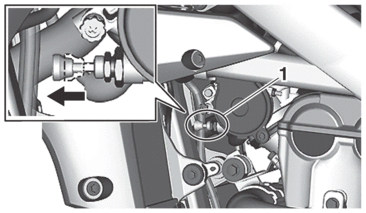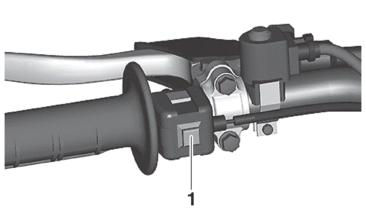FUEL
Always use the recommended fuel as stated below. Also, be sure to use new gasoline the day of a race.
 -
Use only unleaded gasoline. The use of leaded gasoline will cause severe damage to the engine internal parts such as valves, piston rings, and exhaust system, etc.
|
 -
Your Yamaha engine has been designed to use unleaded gasoline with a pump octane number [(R+M)/2] of 91 or higher, or a research octane number of 95 or higher. If knocking (or pinging) occurs, use a gasoline of a different brand.
|
 -
-
For refueling, be sure to stop the engine and use enough care not to spill any fuel. Also be sure to avoid refueling close to a fire.
-
Refuel after the engine, exhaust pipe, etc. have cooled off.
|
Gasohol
There are two types of gasohol: gasohol containing ethanol and that containing methanol. Gasohol containing ethanol can be used if the ethanol content does not exceed 10 %. Gasohol containing methanol is not recommended by Yamaha because it can cause damage to the fuel system or vehicle performance problems.
STARTING A COLD ENGINE
1.Press the shift pedal to neutral.
2.Push the starter knob “1” completely.
 -
-
When the ambient temperature is 15 °C (59 °F) or below, use the starter knob.
-
Do not operate the throttle grip when operating the starter knob.
|
3.Start the engine by pushing the start switch.
If the engine fails to start when using the start switch, release it, wait a few seconds, and then try again.
Each starting attempt should be as short as possible to preserve the battery. Do not crank the engine more than 10 seconds on any one attempt.
4.When the engine starts running, warm this up one or two minutes at a steady speed (of 3000 to 5000 r/min), and then return the starter knob to its original position.
 -
When operating the throttle grip in the closing direction, the starter knob “1” moves in the direction as shown and returns to its original position.
|
 -
Since exhaust gas contains harmful ingredients, do not start or warm it up at an illventilated place or a closed narrow place.
|
5.To stop the engine, push the engine stop switch “1”.
 -
Continue pushing the engine stop switch till the engine comes to a full stop.
|
STARTING A WARM ENGINE
Follow the same procedure as for starting a cold engine with the exception that the starter is not required when the engine is warm.
 -
If the engine fail to start, fully open the throttle grip and push the start switch few seconds to clear the engine of the rich air-fuel mixture retained in it.
|
BREAK-IN PROCEDURES
A break-in is important so that rotating portion, sliding surfaces, and mounted areas may fit one another, and that the rider may become accustomed to the machine.
 -
Before running, do maintenance on the air filter element.
|
1.After warming up the engine, drive it for about 20 minutes at a throttle opening of 1/2 or less.
 -
This model is equipped with an engine auto-stop system. The engine stops automatically if left idling for 7 minutes. If the engine stops, push the start switch to restart the engine.
|
2.Make a pit stop, and check mounted areas for looseness, oil leaks, or other problems.
3.Then, drive it for about 40 minutes at a throttle opening of 3/4 or less.
4.Make a pit stop again, and thoroughly check mounted areas for looseness, oil leaks, or other problems. Thorough checks and adjustments are required in particular for stretch of cables, free play of the brake, stretch of the drive chain, looseness of the spoke, and so on.
 -
After a break-in or after each race, always check the points shown in “TORQUE-CHECK POINTS” for tightening torques and retighten them.
Also when the following parts are replaced, a break-in is required.
-
Cylinder and Crankshaft: A break-in is required for about an hour.
-
Piston, Piston ring, Valve, Camshaft, and Gear: A break-in is required for about 30 minutes at a throttle opening of 1/2 or less.
Observe the condition of the engine carefully during a break-in.
For checkpoints for a break-in, see “MAINTENANCE AFTER BREAK-IN”. If any problem is found, immediately stop the engine and make a checkup.
|
ENGINE STARTING PRECAUTION
Make sure the transmission is in neutral or be sure to pull the clutch lever before pressing the start switch.
 -
If the clutch lever is not pulled and the start switch is pressed with the transmission in gear, the starter motor will cause the rear wheel to spin, which may cause injury.
|







